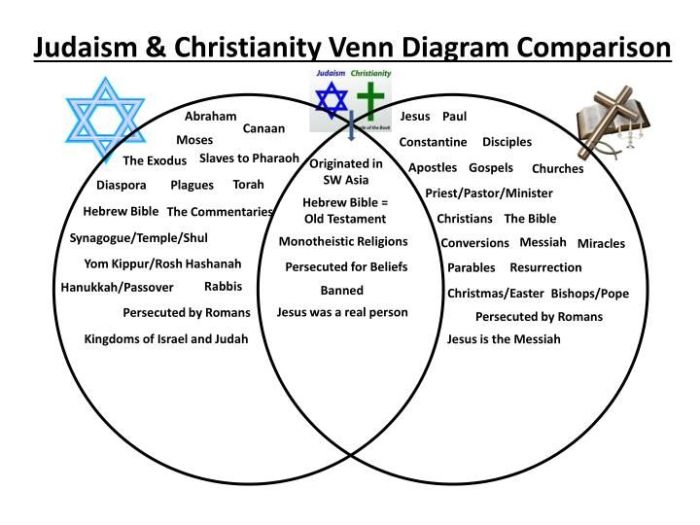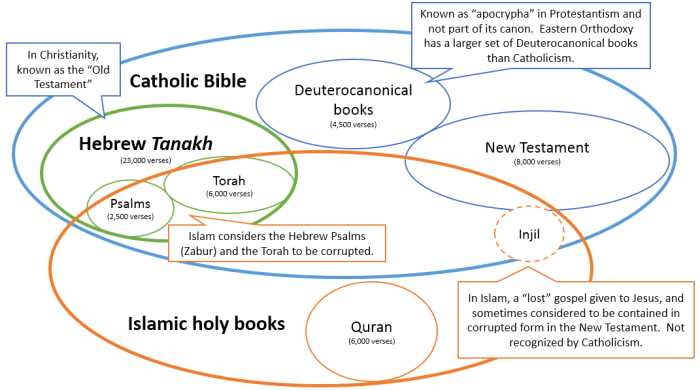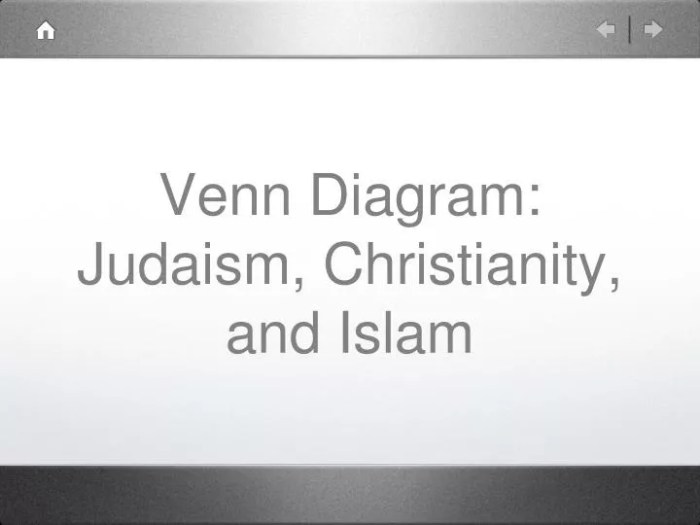Venn diagram of christianity judaism and islam – The Venn diagram of Christianity, Judaism, and Islam presents a captivating visual representation of the historical, theological, and cultural connections and distinctions among these three major world religions. By examining their shared origins, sacred texts, rituals, and social impact, we gain a deeper understanding of the complexities and commonalities that shape their respective beliefs and practices.
Throughout history, these religions have profoundly influenced civilizations, leaving an enduring legacy in art, architecture, literature, and music. Their teachings and practices have shaped the moral and ethical frameworks of societies, fostering both unity and diversity.
1. Historical and Theological Origins

Christianity, Judaism, and Islam share a common historical and theological lineage, originating from the ancient Near East. Christianity emerged as a branch of Judaism in the 1st century CE, while Islam emerged in the 7th century CE, influenced by both Christianity and Judaism.
These religions share a belief in one God, the importance of prophets and messengers, and the concept of divine revelation. However, they also have significant differences in their theological doctrines and scriptures.
Sacred Texts and Beliefs
The sacred texts of Christianity, Judaism, and Islam are the Bible, Torah, and Qur’an, respectively. These texts contain the central beliefs and teachings of each religion.
- Christianity:The Bible consists of the Old and New Testaments, with the New Testament focusing on the life and teachings of Jesus Christ.
- Judaism:The Torah is the first five books of the Hebrew Bible and contains the laws and teachings given by God to Moses.
- Islam:The Qur’an is believed to be the direct revelation of God to the Prophet Muhammad and is considered the most important religious text in Islam.
Rituals and Practices
Christianity, Judaism, and Islam have distinct rituals and practices that shape the daily lives of believers.
- Christianity:Key rituals include baptism, communion, and prayer. These practices are often performed in churches or other places of worship.
- Judaism:Important rituals include circumcision, Shabbat observance, and kosher dietary laws. These practices are often performed in synagogues or other Jewish communal spaces.
- Islam:Essential rituals include daily prayers (salat), fasting during Ramadan, and the pilgrimage to Mecca (Hajj). These practices are often performed in mosques or other Islamic centers.
Social and Cultural Impact
Christianity, Judaism, and Islam have had a profound social and cultural impact throughout history.
- Christianity:Has influenced Western civilization, shaping art, architecture, literature, and music. It has also played a role in the development of education, healthcare, and social welfare.
- Judaism:Has influenced the development of Western monotheism and ethics. It has also contributed to the fields of science, philosophy, and literature.
- Islam:Has influenced Islamic civilization, shaping art, architecture, literature, and music. It has also played a role in the development of science, mathematics, and philosophy.
Interfaith Dialogue and Understanding, Venn diagram of christianity judaism and islam
Interfaith dialogue and cooperation among Christianity, Judaism, and Islam are essential for promoting understanding and coexistence.
- Challenges:Differences in beliefs and practices can create barriers to interfaith dialogue.
- Opportunities:Common values and shared experiences can provide a foundation for cooperation and mutual respect.
- Initiatives:Initiatives such as interfaith councils, educational programs, and community outreach events aim to build bridges between different faith communities.
Questions and Answers: Venn Diagram Of Christianity Judaism And Islam
What are the main differences between Christianity, Judaism, and Islam?
The key differences lie in their theological doctrines and scriptures, including the nature of God, the role of Jesus Christ, and the importance of the Torah, Bible, and Quran.
How have these religions influenced world history?
They have played a significant role in shaping civilizations, inspiring art, architecture, literature, and music. They have also influenced legal systems, social structures, and ethical values.
What are some examples of interfaith dialogue and cooperation?
Initiatives such as the World Council of Churches, the Interfaith Alliance, and the Parliament of the World’s Religions promote understanding and collaboration among different faith communities.

